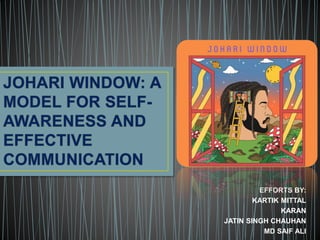JOHARI WINDOW.pptx
•Download as PPTX, PDF•
0 likes•2 views
presentation on johari window
Report
Share
Report
Share

Recommended
Recommended
More Related Content
Similar to JOHARI WINDOW.pptx
Similar to JOHARI WINDOW.pptx (20)
JOHARI WINDOW.pptx
- 1. EFFORTS BY: KARTIK MITTAL KARAN JATIN SINGH CHAUHAN MD SAIF ALI
- 2. • The Johari Window is a powerful model developed in 1955 by Joseph Luft and Harry Ingham to help individuals and groups understand and improve their communication and relationships. This model provides a framework for exploring self-awareness and the dynamics of information sharing between people
- 4. • The Johari Window is divided into four quadrants, each representing different categories of information: • Open Area: This quadrant represents information known to both the individual and others. It includes facts, behaviors, feelings, and experiences that are openly shared and discussed. • Blind Area: This quadrant represents information unknown to the individual but known to others. It includes blind spots, unconscious biases, and feedback that has not been received or integrated.
- 5. • Hidden Area: This quadrant represents information known to the individual but unknown to others. It includes private thoughts, feelings, experiences, and values that are not readily shared with others. • Unknown Area: This quadrant represents information unknown to both the individual and others. It includes unconscious motivations, hidden talents, and unexplored areas of potential.
- 6. • The Johari Window offers several benefits for individuals and groups, including: • Improved Self-Awareness: The model helps individuals gain a deeper understanding of their strengths, weaknesses, and communication styles. • Enhanced Communication: By increasing openness and decreasing blind spots, the model facilitates more effective and authentic communication.
- 7. • Some thing are perhaps better not to Communicated (like mental or health problem) • Some people may pass on the information they received further then we desire. • Some people may react negatively. • Using Johari window is useless exercise if it is not linked to the activities that reinforce positive behavior or that correct negative behavior. • Some cultures have a very open and accepting approach to feedback and others do not. • Some people take personal feedback offensively.